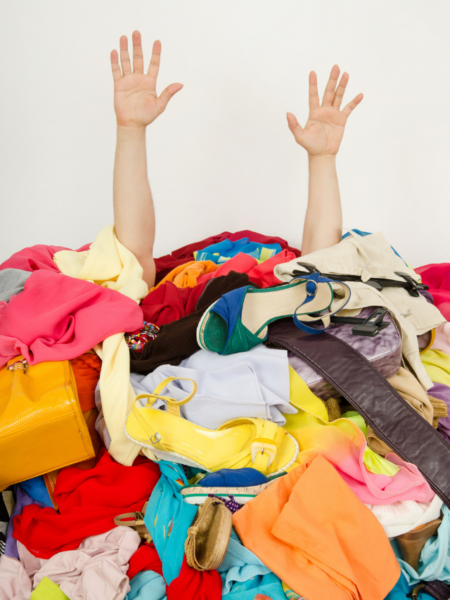Decluttering
How To Use A Simple Glass Of Water To Stop Chronic Clutter
In this post, I will reveal how using the amazing glass of water method can prevent chronic clutter from taking over your home!
Prefer to read without the ads? You can grab the PDF file here for only $5. You can print it out and it will be available for you to read anytime you want (click on the book below to purchase)
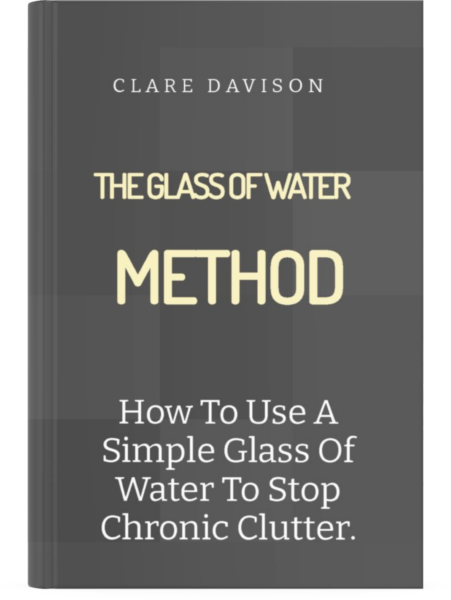
What is chronic clutter?
The Meriam Webster definition of clutter is to fill or cover with scattered or disordered things that impede movement or reduce effectiveness.
For instance:
- If things fall out of a cupboard when you open it.
- Stuff scattered on the floor, hindering walkways.
- Rooms so stuffed that you can freely walk around.
- Laundry is scattered everywhere.
We are all moving to different stages in our lives, from students to parents, then on to retirement.
Each stage in our lives brings different challenges from the last, for instance, your home will run differently when you have a family, to when you were a student.
When you retire, you’ll probably have much more time on your hands however, you may be limited health-wise or suffer from chronic pain, and struggle to keep on top of the most basic tasks.
In this post I will show you a brand new technique using only a glass of water, to help prevent chronic clutter!
Yes, you heard it right, the glass of water method has helped many of my students in their journey to conquering chronic disorganization and clutter.
Working as a professional organizer and cleaner for over 13 years, I’ve seen some amazing organizing systems that people have used in their homes. Over time, I’ve seen how these systems fail and all the hard work is wasted. Often the system failed because it was unworkable, especially for anyone who was chronically disorganized.
Before we talk about this amazing glass of water method, let’s discuss different examples of disorganization.
Situational disorganization.
Situational disorganization is where life suddenly gets on top of you, and things spiral out of control. This could be due to a work situation, a bereavement of a loved one, becoming a new parent, or any other number of life-changing situations.
One minute you were doing fine, the next minute things have just completely got out of control and you are having trouble getting organized.
Sometimes it may be due to bad habits such as never dealing with paperwork as it lands on the mat or allowing the laundry to pile up.
Chronic disorganization
Chronic disorganization is defined by the ICD as a lifelong struggle with clutter and disorganization in which self-help efforts haven’t worked, this can be caused by many different situations such as:
- ADHD
- Depression
- Anxiety
- Aspergers
- Mental health
- Hoarding disorder
- Compulsive buying
- Aspergers
- Downsizing
- Grief
- Brain injury
- Learning Disabilities
- Poor time management skills
And many more, which can manifest itself in:
- Piles of laundry lying around
- Piles of paperwork, books, boxes, bags, or magazines
- You are always running late or behind schedule
- Missing important dates
- You feel embarrassed to invite anyone to your home as you are embarrassed by the clutter.
- The floor is constantly covered in toys and laundry
- You can never find anything, so you often buy it again
- You feel you are constantly winging it and flying by the seat of your pants.
If you feel you are affected by any of the disorders listed above, try to seek a medical professional’s help.
Professional organizers and organizing services can help to design strategies to help you cope with your situation. However, they may not help you with other more challenging disorganization as this is not their role.
Try this simple chronic disorganization test
If you answer yes to these three questions, you may suffer from chronic disorganization and may need to seek medical help.
- Have I been disorganized most of or all of my life?
- Have my efforts to improve my level of organization ultimately failed
- Does my disorganization cause negative feelings or consequences on a daily or near-daily basis?
For more information visit the ICD
So, for now, we will address situational disorganization and how we can prevent it from turning into chronic clutter. And, I’m going to show you how a simple glass of water can help with clutter!
Why do we have chronic clutter?
- Clutter happens when we have too much stuff for the space we have. Most households could probably easily get rid of 70% of their belongings without it having a negative impact on their lives.
- Clutter happens when our belongings do not have a place and are just left lying around.
- Clutter is just an accumulation of lots of small indecisions, so you put stuff down somewhere rather than dealing with it at that moment.
- Chaos and clutter happen when we keep adding stuff to our home without letting go of the same amount of stuff.
Why do we keep making the same mistakes when it comes to chronic clutter?
It’s difficult to visualize how our spending and buying habits impact our home and intensify our clutter problem. Our buying habits wreck our homes in a slow drip rather than a tsunami. If someone threw all the items that you purchased throughout the year into your home all at once, then you would most definitely see the impact of your impulse purchases. You don’t notice the build-up of clutter because it happens slowly over time.
So how can a simple glass of water help prevent chronic clutter?
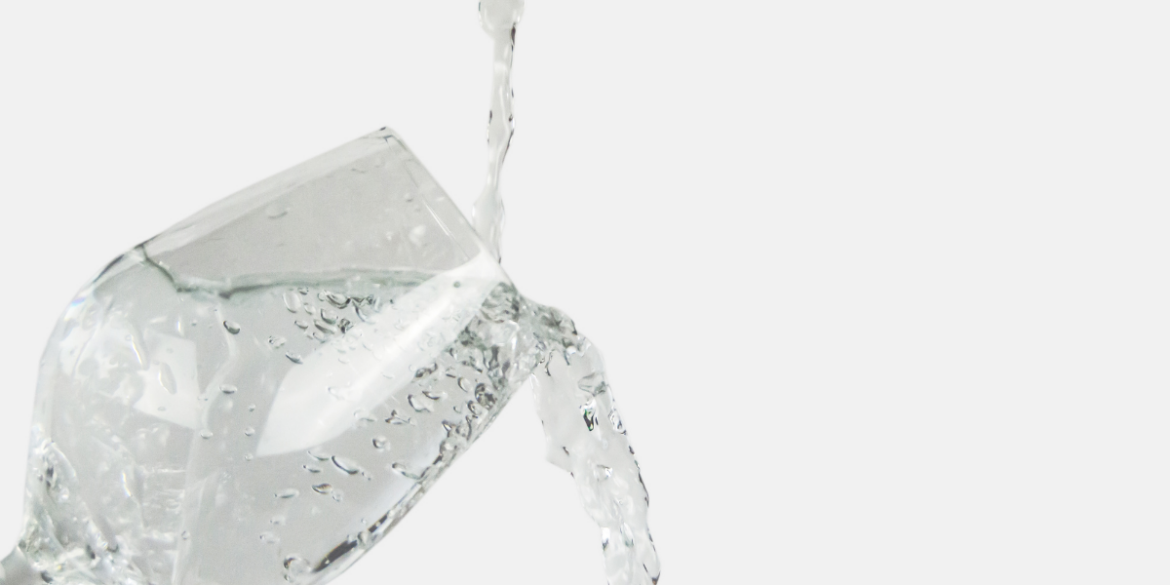
Imagine you were thirsty, went to the sink, and poured yourself a glass of water.
You drank some, quenched your thirst, then filled your glass back up to the top just in case you needed some later.
An hour later, you added more water to the glass, even though you didn’t need it, and you were not going to drink it.
Throughout the day you kept topping up your glass with water until your glass was overflowing and you didn’t empty any of the water out.
Eventually, you’re in a mess and overwhelmed by the flood of water.
This is exactly what happens almost every day in your home. Items are coming in, but nothing is going back out of your house in the same volume, causing a flood of belongings that not only doesn’t stop but just keeps getting worse.
Why do we do that?
Why do we keep pouring a steady stream of objects into our homes instead of stopping when our space is full?
Because we allow the designated space for items to overflow into another space (think countertops, floor, spare room, basement, garage, garden) this then causes that space to become cluttered and makes the problem worse.
So, in the glass of water analogy, you would be allowing your water to overflow onto the saucer, then the sink, which in the short term isn’t going to affect you much, but over time the sink would run onto the floor and you’d soon be in deep water (pardon the pun!) All of which could have been avoided if you’d stop filling up your glass with water in the first place.
If you don’t believe it’s that simple to stay decluttered, try it for yourself!
How to prevent chronic clutter
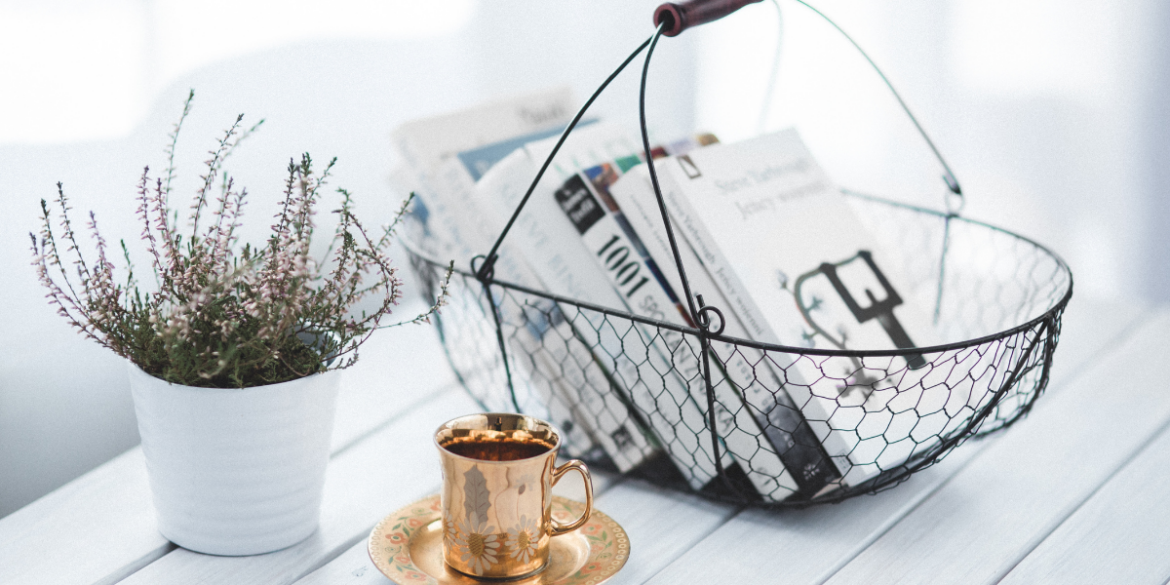
Now before we start, I am not a fan of baskets! Let me explain: They are great for shoes in the entrance, blankets, and spare loo rolls. But I do not like to use a basket for hiding stuff, or for extra storage. The reason for this is that once something goes in a basket, it’s gone forever into the chronic clutter black hole. You can’t see it, and you don’t deal with it.
When I talk about storage and baskets in this post, I am always talking about clear boxes or shallow trays so you can see the contents at a glance.
- Declutter by category
Go through each category of your belongings and apply the glass of water method.
- Use see through containers
Store each category of items in a transparent container big enough to hold only the minimum of what you need.
- Keep within your container limits
If it doesn’t fit in your container, you can’t bring it into the house.
Kitchen cupboard clutter
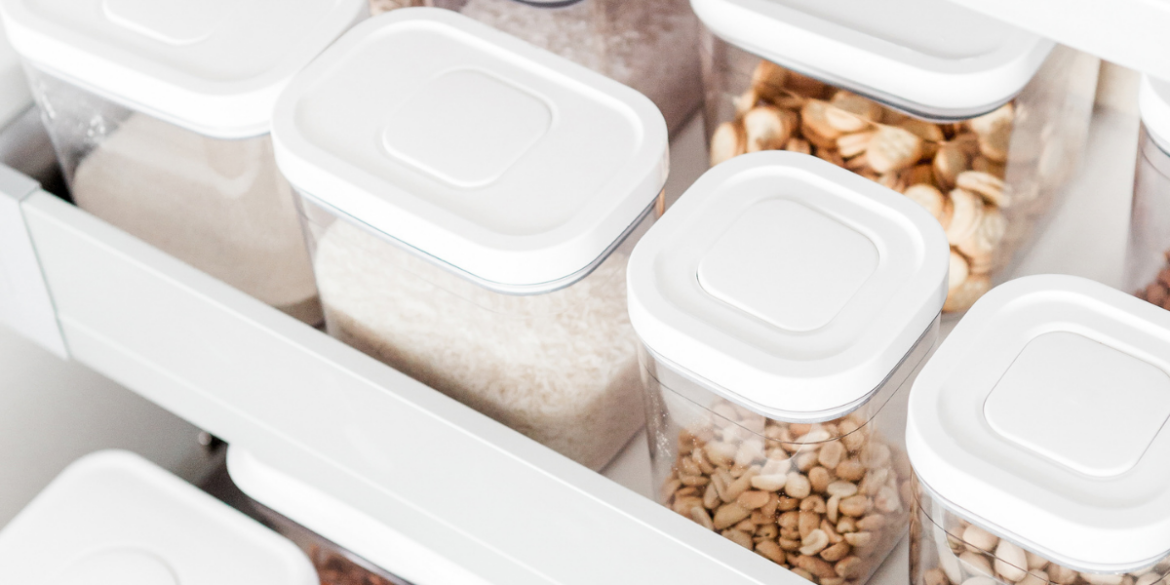
Now, let’s apply the glass of water theory to one of your kitchen cupboards.
Problem
The cupboard where you keep your tins is overcrowded. You can’t see what’s in there because there are packets of other stuff that don’t belong there. Next time you go to the supermarket, you struggle to remember whether you need beans or tomato soup because you can’t remember whether you saw them in the messy cupboard, so you buy them anyway just in case. You get home and open the cupboard and shove the tins into the already bursting cupboard. You notice you already have several tins of soup and beans at the back of the cupboard.
Solution
Use a clear, shallow basket, like these ones with enough space to hold only the tins you use. When you can see what you’ve got in your cupboard, you don’t buy any more until you need to.
I can tell you exactly how many tins of tomato soup, beans, chickpeas, etc. I have in my kitchen because I can picture the baskets in my cupboard without even opening the cupboard door. This means I don’t even have to check the cupboards before I go shopping which again is a time saver!


Pet food clutter
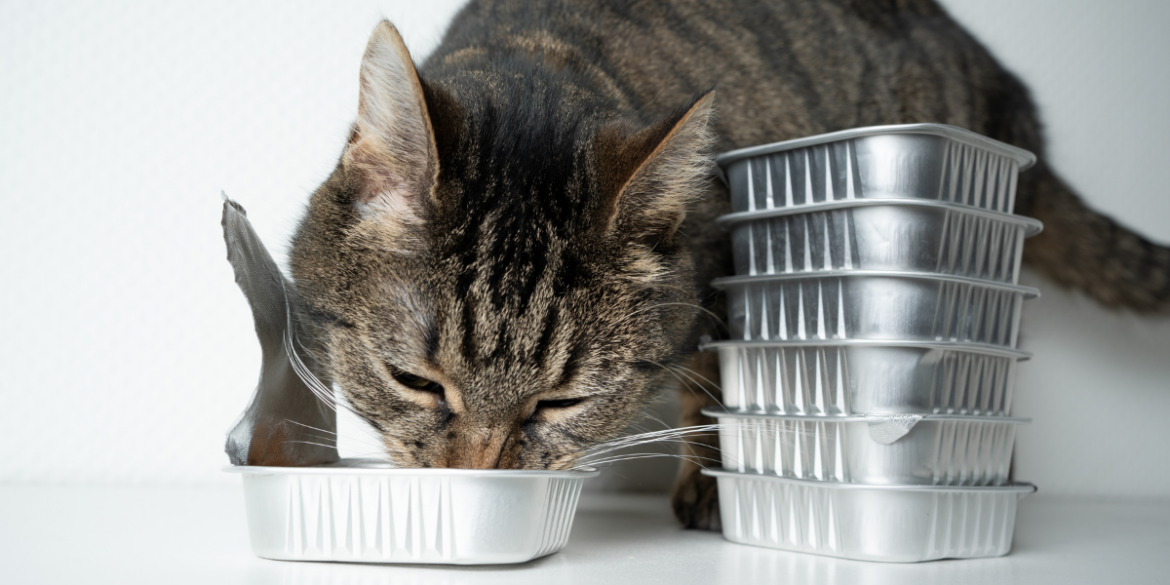
Let’s try the same theory with pet food
Problem
You have a messy cupboard full of half-opened boxes and packets and are always running out of pet food.
Solution
Remove all the packets of pet food from the boxes and store them in a transparent shallow box like this one, so you know at a glance exactly how much pet food you’ve got and exactly when you need to buy more.


Cosmetics clutter
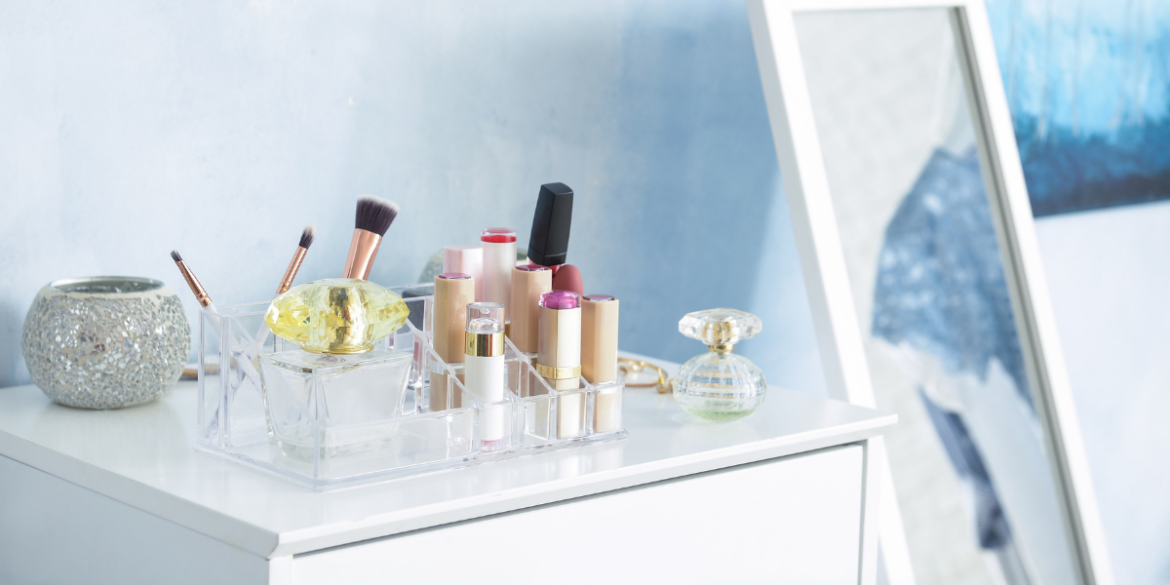
Let’s check the glass of water theory with cosmetics!
Problem
I tend to buy red lipstick wherever I go! I recently sorted out my red lipsticks and realized that I kept colors that didn’t suit me, matt finish which I hate, and colors I’d never worn. I got rid of most of them and only kept about three that I actually wear.
Solution
I then found a small see-through tray like these ones big enough to hold these three lip colors and no more.
When I’m in a shop now and tempted to buy a new red lipstick, I know I have to get rid of one first.
I also realize that I don’t need to buy a new one because I’m happy with the ones I’ve kept.
Under the sink clutter

Who doesn’t love to buy all the latest products to make our homes smell lovely and clean?
Remember, you’ve actually got to use these products to keep your home clean. Having hundreds of bottles under the sink is never going to be enough to keep your home clean.
Problem
Under the kitchen sink is cluttered and there’s no room to find anything. You keep buying cleaning products you already have and every time you open the sink cupboard you are faced with a huge jumble of stuff.
Solution
Sort the cleaning products you already have by type:
- Disinfectants
- Polish
- Antibacterial
- Bleach
You probably need to use up everything you already have before you can organize under the sink properly, so temporarily put the different product types into separate transparent baskets with only enough space for the ones you’ve already got, you’re not going to be buying any more!
Once you’ve used all the products you’ve already bought, streamline your cleaning products to one basket only. If it doesn’t fit in the basket, then you don’t need to buy it!
See how you can clean your house with very few products by reading what grandma used to keep in her cleaning kit in this post, you’ll be surprised how little you really need to keep in your cleaning cupboard!


Closet clutter
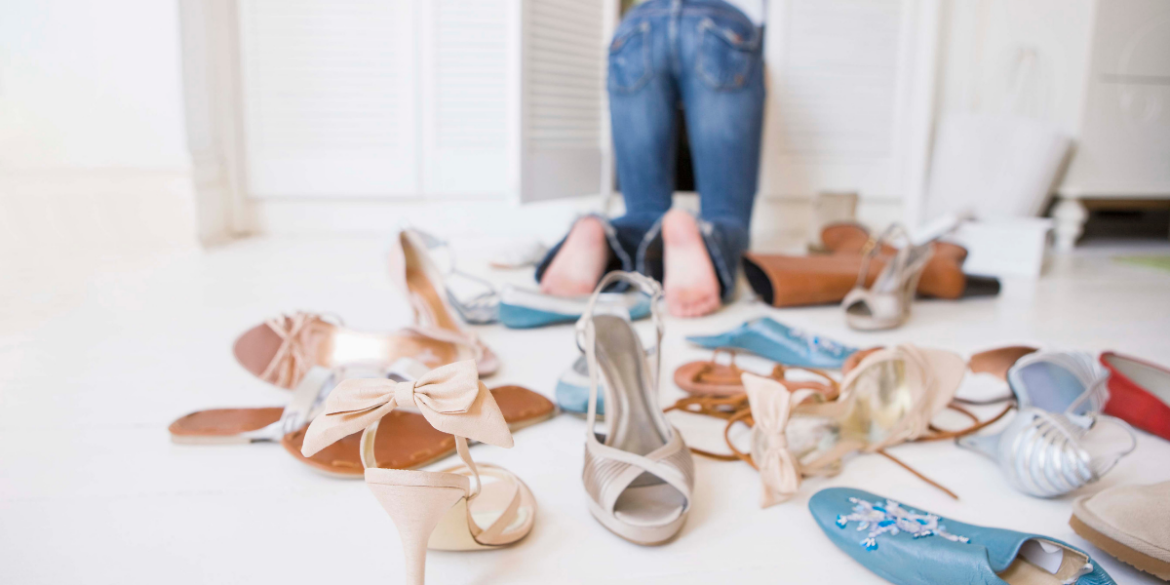
Let’s think about your closet for a second. Is it a magnet for chronic clutter? How can the glass of water method help here?
Do you have more than you need? Of course, you do!
Most of us have more clothes than we really need because we are not living in a Charles Dickens novel, and one set of clothes is not going to be as socially acceptable as it was then.
So how do we deal with chronic clutter in our closet?
Well, we have a few options here.
- We can go on the capsule wardrobe route.
- The personal uniform route (my personal favorite),
- Or you can pare down what you already own to fit the space you have (like the glass of water) rather than trying to create more storage to hold your 30 pairs of shoes.
- You can find out how to do that in this post!
Kids clutter
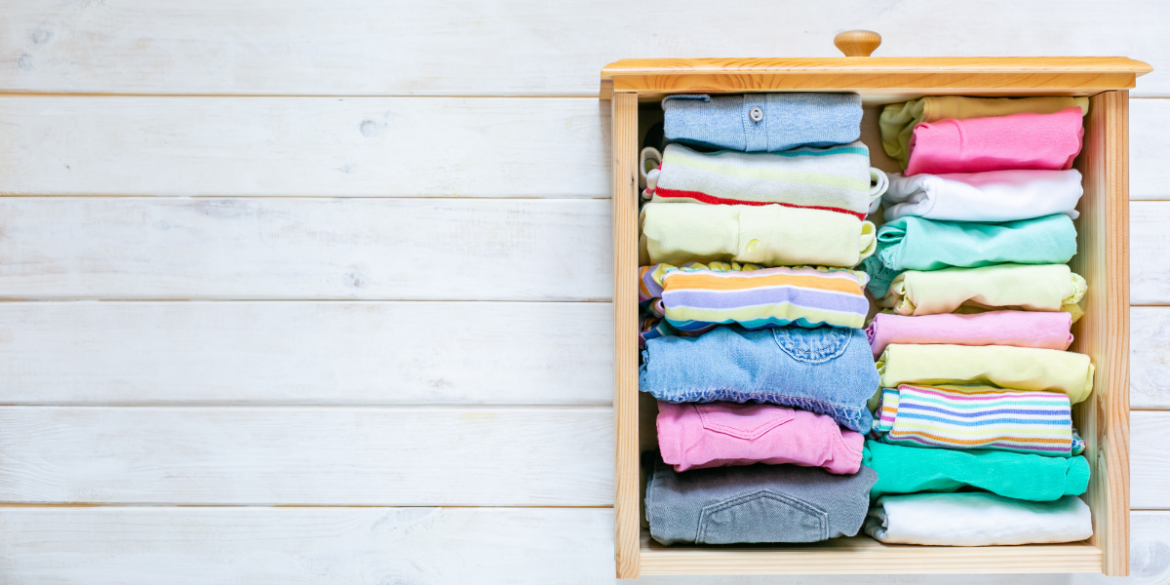
Let’s apply the method to kid’s rooms
This is probably the most noticeable area where the overflow is obvious.
Problem
My daughter’s room (age 13) was always a huge mess. She seemed completely unable to keep her room tidy and organized. She could never find something as simple as a deodorant when she needed it.
Solution
After a massive purge one day, we categorized and organized all her stuff between us, and small see-through baskets were used for the following:
Drawer 1
- Knickers
- Socks
- Bras
- Tights
Drawer 2. Small shallow trays held:
- Nail polishes and cotton wool
- Hair bobbles brushes
- Deodorants and perfume (before this, she has 7 or 8 bottles of perfume that she never used)
- Makeup


Drawer 3 contains:
- Jeans and leggings
- T-shirts and jumpers
- Since the coronavirus has hit, she also has a basket for clean facemasks to grab before school.
These are not in a basket as there are only as many as will fit comfortably in the drawer.
Drawer 4 contains:
- Stationary, pens, and pencils in a shallow plastic container
- Drawing pads and paper
Drawer 5 contains
- Electronics
All other clothes are hung up in the wardrobe and at the bottom of her wardrobe is space for her school rucksack and a basket of shoes
Since implementing the tray system, she now knows exactly where to put things back in her room as everything has a place, and nothing is encroaching into other areas. She now uses every single item in her room and loves the feeling of space and tidiness, and 90% of the time, she’s keeping it tidy.
She also has a bin and a laundry basket in her room so she’s responsible for her rubbish and laundry.
As a side note, we don’t allow food upstairs to reduce the clutter from plates and cups, etc.
So why does it work? Because my daughter no longer buys stuff that she doesn’t need. She knows when something is running out, and she can see exactly what she owns. She is organized and not living in chronic clutter anymore.
Give it a go!
Why don’t you try the glass of water method with just one drawer and see how it works for you. Try organizing your stuff for the space you have rather than trying to create space for your clutter. Get rid of the stuff you don’t need and stop buying more stuff.


Start with your underwear drawer and see what you can get rid of. Only keep what will fit in your space without feeling cramped. Can you easily find things? Is it easy to put stuff away, if not, why not!
Remember to look at each area and category of your house like a glass of water. Don’t let your drawers and cupboards spillover. Try to fill each space and drawer less than half full. Things will be easier to find and easier to put away for not just you, but the whole family!









